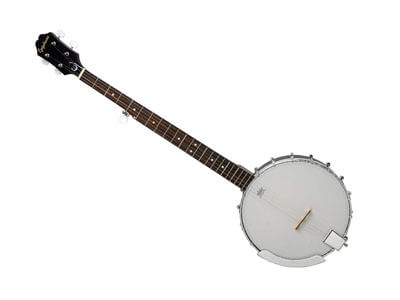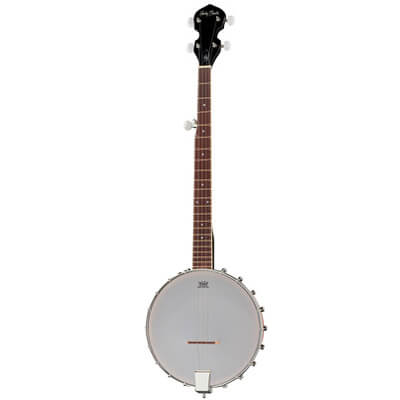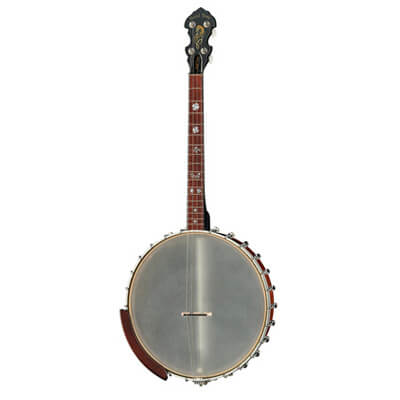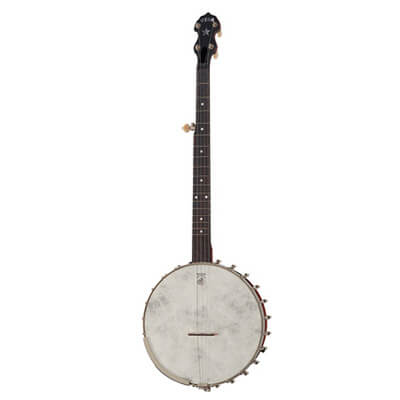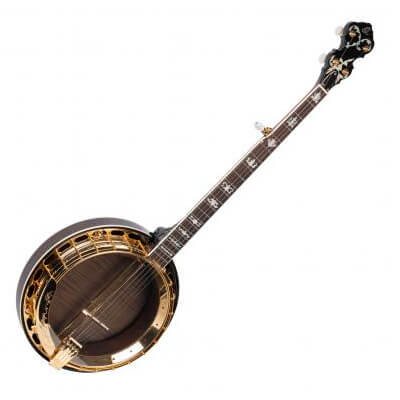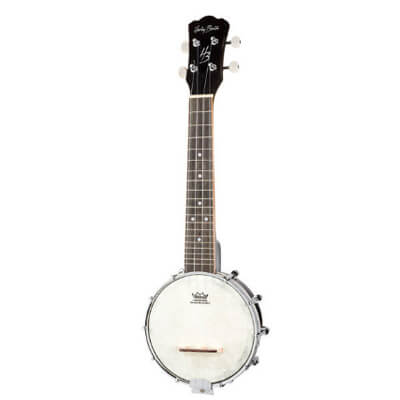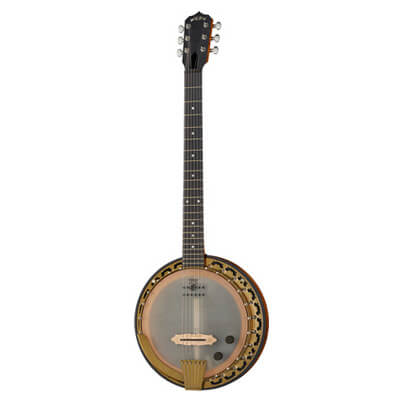Buying a banjo: My 9 best recommendations for 2025
Here you will find the best banjos for beginners, advanced players, professionals and children that I can recommend. Before you buy, check out the most important questions and answers to help you make a good choice.
This text has been translated into English. Please report spelling mistakes to sebastian@musiksocke.com
What kind of banjo are you looking for?
Frequently asked questions:
Generally, a banjo has four or five strings, but there are also models with six strings. A distinction is made between tenor, bluegrass and plectrum banjos. These individual designs differ not only in shape but also in sound and are therefore used for different styles of music. So the first question before buying such an instrument is what kind of music you want to play.
Banjo for beginners
With a banjo it is important to pay attention to the quality and playability. The strings must be neither too high nor too low, the tuners must be smooth-running and at the same time very stable. And the skin must be well tensioned and in perfect shape.
It should be noted that banjos are equipped with steel strings. At the beginning of a career, these strings can sometimes cut a little into the fingertips of the gripping hand. But don’t worry. After only a short time, the fingers will have adjusted.
The Epiphone MB-100 is a good bluegrass banjo with 5 strings and an open back. In my opinion, it offers the best value for money. The tuning is kept for a long time despite the simple mechanics and the sound sounds like the typical banjo sound. For beginners with a small budget, the MB-100 is a good choice and is perfectly adequate. Later, you can improve the sound with high-quality strings.
The Harley Benton BJO-35Pro is well suited as a first banjo. It is a typical banjo with 5 strings and an open back. The workmanship is impeccable on all components. I could not find any poorly finished edges or screws. The sound is nice and clean for this price range and quite loud. You definitely need tolerant neighbours when practising. I know some experienced musicians who use the BJO-35Pro as a second instrument.
Banjo for advanced players
There comes a time when you want to switch to a higher quality professional banjo. For example, if you have the idea of playing in a band or making your own recordings, it makes sense to buy a higher quality instrument.
We always recommend banjos from brands that have been manufacturing stringed instruments for many years. Thus, banjos in the mid-price segment are quite available that meet most requirements for professional recordings or performances.
The Gold Tone Irish Tenor Banjo 12 is a good tenor banjo with 4 strings. With 17 frets and 4 strings, it offers an easy transition from guitar to banjo. There is nothing to complain about in terms of playability. If you are already committed to folk or jazz music, this banjo is a good choice. The sound is rather mellow and powerful and differs clearly from the traditional banjo sound. I find that the maple wood used gives the instrument a special look. All in all, a good tenor banjo.
The Gewa VGS Banjo Premium is a high-quality tenor banjo with 5 strings. I like the deep sound with a decent volume at the same time. With it, you can also assert yourself well in a band and show off your skills. The mechanics are well-made and make it pleasant to play. The price is rather low for a tenor banjo, but I think that this instrument can also be used by advanced players.
Banjo for professionals
In the professional field, frugality should not prevail. If you want to earn money professionally with music, you need an instrument you can rely on completely. Moreover, there are banjos that are so wonderfully tuned that even the most complicated phrases and the fastest melodies succeed like magic. Professional banjos should not be without pickups. Often these are hardly recognisable at first glance and therefore do not disturb the beautiful appearance of an artistically decorated banjo.
The Deering Vega Old Time Wonder 12″ is a professional banjo with 5 strings. It has a rich, deep tone and is mainly suitable for the clawhammer style due to the cut-out frets. The action is as smooth as I have ever experienced on any other banjo. There is nothing to complain about in the workmanship. The banjo is optimally adjusted at the factory and only needs to be tuned after receipt. The high price is more than justified for this completely well-made banjo.
The Ortega OBJ850-MA 5-String Banjo is a banjo for professionals who play different styles. It has a clean and rather bright sound. It is wonderfully playable and creates a feeling of easiness when playing. This makes it ideal for a variety of musical styles. The mechanics, string action and skins are – as you would expect at this price – of high quality and fit well into the overall picture.
Banjo for kids
Can children already learn to play the banjo? Yes, of course they can. There are just a few things to consider.
Unlike guitars, where the classical guitars are strung with nylon strings, banjos have steel strings. So with models for kids, you should always make sure that the string action is not too high. Of course, the size of the child also plays a role. The neck of a plectrum banjo, for example, with 22 frets, is much longer than the neck of a bluegrass instrument. You should also keep an eye on the workmanship of all metal parts. The metal around the body and all screws should not protrude too far and should not have any edges.
If you want to be on the safe side, you should read up on banjo ukuleles. This is by no means a waste of money because banjo ukuleles can be a lot of fun for young and old alike and often have a great sound.
The Kmise Banjolele is an affordable banjo for kids with 4 strings. It comes in a set with a bag and a tuner. Despite the rather cheap materials, the ukulele banjo is easy to play and is perfectly sufficient for a start. Adults will also have fun with this nice instrument. The sound is rather average, but can easily be upgraded with better strings.
The Harley Benton BJU-10 is a beautiful children’s banjo in ukulele size with 4 strings. The sound is quite loud and sounds typically like a banjolele. The mechanics are okay, you can’t expect more for the price. I have been told that there are often instruments with defects. If you get such an instrument, the online shops will exchange it for a better one.
Banjo for crazy people
The combination of wood, metal and skin gives birth to infinitely beautiful splendours. Here one encounters gimmicks with gold, mother-of-pearl and even precious stones. Elegant embossing often adorns the metal and elaborate graphics embellish the skins. Some banjos are works of art, masterpieces of craftsmanship and sonorous experiences all in one. These instruments have nothing left of the simple instrument of a hillbilly or a 19th century slave. And yet it was these people who got so much out of these instruments that it would almost be a sin not to erect a magnificent monument to them. And when it makes such great music, it is worth every penny.
The Deering Phoenix A/E 6-string banjo is a top class instrument. The big difference in price is due to the materials used and the pickup. The mechanics are also of high quality and have been worked on with attention to detail. The sound is correspondingly pleasant and the humbucker picks up the notes cleanly. It is important to mention that the Phoenix A/E has 6 strings, which make it easy for guitarists to change.
How do I recognize a good banjo?
When the strings are struck or plucked, vibrations are created that are transmitted to the whole instrument. This is no different with a banjo than with a guitar, mandolin or bouzouki. However, these vibrations are so quiet that they have to be amplified. The skin of the banjo is primarily used for this purpose, whereas on most other stringed instruments the sound is amplified in the body and transmitted through the sound hole. So, unlike a guitar, it is not only the quality of the wood that is important on a banjo, but also the quality of the metal and the skin.
The skin itself is tightened with screws on the body until it reaches an optimal tuning. Here, it should be carefully checked whether the tensioning screws are smooth-running and reliably hold their position. The head must also be checked to make sure that it is not damaged in one place. The strong tension of the skin must always be guaranteed.
The bridge of the banjo is attached to the head. It must not slip and sharp edges must not press into the skin.
The wood of the resonator of a banjo is not as heavily stressed as the metal ring with the tensioning screws. Nevertheless, the resonator must not show any cracks and should be able to be removed without complications.
As far as the neck, the frets and the tuners are concerned, the same procedure should be followed as with a guitar.
All this should be ensured before buying a banjo. It is important to try playing the instrument before buying it. This way, you can also determine, for example, whether individual fret rods extend over the edge of the neck and could thus lead to injuries. In addition, the frets must all be the same height.
What accessories do I need?
If you want to get started immediately and be prepared for all eventualities, you should buy the following accessories for your banjo:
First of all, there is a suitable case or bag to transport the banjo safely. There are different sizes for each type. A good all-rounder is this bag: Protec Deluxe Banjo Gig Bag CF204. The bag is well padded and big enough for most banjos. Compare the dimensions beforehand, a banjo up to 95 x 37 x 13 cm would fit in here. The bag can be carried like a backpack and is therefore well suited for transport.
Then you should think about whether and which capo is suitable for you. There are special models of banjos from the Ortega company. The Ortega OCAPOUKE-CR is a solidly built capo that clamps well. It is important that the pad is rubberised. Ortega also has other colours available.
Many banjo players use thumb and finger picks to create the typical banjo sound. Those who have never used these playing aids should try it as early as possible. In the beginning, a set of picks for the thumb and fingers is recommended. For beginners, the d’Andrea Fingerpick Set Medium with plastic picks is suitable. With more experience, individual picks can be purchased.
Of course, spare strings are also useful in the luggage. The Deering 5 String Banjo Medium Set produces a great sound. In the beginning, you should also try out other strings to find out which ones produce the best sound on your own banjo. I recommend the strings from Deering, which are a little more expensive, but can also get a lot of sound out of inexpensive banjos.
Many banjo players use a strap to hang around their neck. Personally, I find the Fender Banjo Hootenanny Strap suitable for most banjos. However, this is a subjective choice and beauty is in the eye of the beholder. I am sure you will find a strap that fits!
A stand for the banjo is also very practical. I find a floor stand that holds the banjo upright is best. It is important that the instrument is secure and stable in the stand. But there are also good wall mounts or special constructions. A banjo also looks good on the wall and is protected from damage. A classic stand with easy handling and high stability is the K&M 17670.
Learning the banjo is not difficult if you have a little perseverance and the right textbook. Of course, there are also many digital offers in the form of apps and courses, but I still find the “analogue” variant the best for learning. A helpful textbook is “Playing Banjo for beginners and advanced players”. With 300 pages, it is very comprehensive, but the content is simple at the beginning and then slowly becomes more and more advanced.
Tools for adjusting the tensioning screws as well as care material for the skin, wood and metal are often used from the guitar sector. Once you have all this together, there is only one thing left to say: Have fun playing!
Which banjo brand is the best?
Together with musicians, I have compiled this list of the best brands of banjos. These brands have been around for many years and have consistently shown high workmanship and good quality musical instruments over the decades.
How much does a good banjo cost?
A good banjo costs between 500 and 800 euros. Beginners can start with instruments that are in the range of 100 to 300 euros.
The difference between this and a good banjo for advanced players lies in the workmanship and the sound. However, since beginners must first learn the basics and develop an enthusiasm for the banjo, it is advisable to start with an inexpensive model. After that, you can switch to a high-quality banjo.
Here are my recommendations for good banjos.
What is the best banjo for beginners?
For beginners, the Epiphone MB-100 Open Back Banjo is particularly suitable for about 250 euros. This is an inexpensive banjo for beginners, which has a good price-performance ratio.
If the practice phases become longer and playing the banjo is fun for a long time, it is advisable to change to a high-quality instrument. For advanced players, the Gold Tone Irish Tenor Banjo 12 for about 850 Euros is my recommendation.
Here you can find out more details for beginners.
⚠️
* For the links marked with a star, we receive a commission on a purchase. The price does not change for you. Please use our link and support the independent work of Musiksocke. Thank you very much!
✔️
The product recommendations made here are based on my experience and conversations with expert musicians. All products presented here meet the criteria of the checklist.
🏦
All prices are incl. VAT plus shipping costs. The amount was estimated by me and may differ from the actual price. As an Amazon partner, I earn on qualified sales. This also applies to Thomann, Kirstein and all other partners.
String instruments:
Wind instruments:
Key instruments:
Drums:
Recording:


